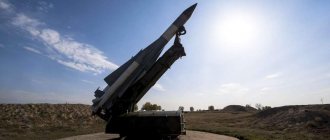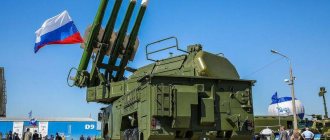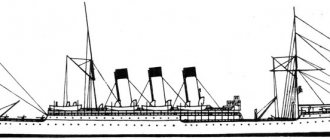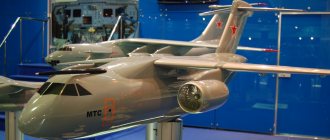No longer a toy, not yet a weapon
The term “laser,” which is familiar to us, is an abbreviation for Light Amplification by Stimulated Emission of Radiation, which translated means “amplification of light through stimulated emission.”
Lasers were first discussed seriously in the second half of the 20th century. The first working laser device was introduced by American physicist Theodore Maiman in 1960, and today lasers are used in a wide variety of fields. Quite a long time ago they found application in military equipment, although until recently we were talking mainly about non-lethal weapons capable of temporarily blinding the enemy or disabling his optics. Full-fledged combat laser systems capable of destroying equipment are still at the development stage, and it is difficult to say exactly when they will become operational.
The main problems are associated with the high cost and high energy consumption of laser systems, as well as their ability to cause real damage to highly protected equipment. However, every year the leading countries of the world are increasingly developing combat lasers, gradually increasing the power of their prototypes. The development of laser weapons would most correctly be called an investment in the future, when new technologies will make it possible to seriously talk about the feasibility of such systems.
Advantages
The advantages of this type of laser weapon include:
- Stealth. When using a laser, there are no external signs such as fire, smoke and sound.
- High accuracy.
- Instant action. The object burns in a matter of seconds. It takes very little time to transfer the beam to a new target.
- Straightforwardness.
- High speed. The subject has no time to dodge.
- No recoil.
- Infinity of “ammunition”. It depends only on the power of the energy source.
winged laser
One of the most sensational projects of laser combat systems was the experimental Boeing YAL-1. A modified Boeing 747-400F airliner served as a platform for placing the combat laser.
Airborne combat laser: experimental Boeing YAL-1 / ©NS
The Americans have always been looking for ways to protect their territory from enemy missiles, and the YAL-1 project was created precisely for this purpose. It is based on a 1 MW chemical oxygen laser. The main advantage of the YAL-1 over other missile defense systems is that the laser system is theoretically capable of destroying missiles at the initial stage of flight. The American military has repeatedly announced successful tests of a laser system. However, the real effectiveness of such a complex seems rather doubtful, and the program, which cost $5 billion, was discontinued in 2011. However, the developments obtained in it have found application in other projects of combat lasers.
Boeing YAL-1 is an analogue of the Soviet A-60 aircraft laser system. The Il-76MD served as the base for the A-60 laser complex, and its first flight took place in 1981. It was expected that the main task of the complex would be the fight against enemy reconnaissance aircraft. After the collapse of the USSR, work on the A-60 was frozen, but has now been resumed.
Laser weapons: technology, history, status, prospects. Part 1
Laser weapons always cause a lot of controversy. Some consider it a weapon of the future, while others categorically deny the likelihood of effective examples of such weapons appearing in the near future. People thought about laser weapons even before their actual appearance; let us remember the classic work “The Hyperboloid of Engineer Garin” by Alexei Tolstoy (of course, the work does not exactly indicate a laser, but a weapon close to it in action and consequences of use).
The creation of a real laser in the 50s and 60s of the 20th century again raised the topic of laser weapons. For decades, it has become a fixture in science fiction films. Real successes were much more modest. Yes, lasers have occupied an important niche in reconnaissance and target designation systems and are widely used in industry, but their power was still insufficient for use as a means of destruction, and their weight and size characteristics were unacceptable. How have laser technologies evolved, and how ready are they for military use today?
The first working laser was created in 1960. It was a pulsed solid-state laser using artificial ruby. At the time of creation, these were the highest technologies. Nowadays, such a laser can be assembled at home, and its pulse energy can reach 100 J.
Scheme of the first artificial ruby laser
A homemade laser on an artificial ruby with a pulse energy of 5 J and a coin shot through seven pulses of this laser, the laser was built by @Laserbuilder, they plan to create a similar laser with a pulse energy of up to 100 J
A nitrogen laser is even simpler to implement; it does not require complex purchased products; it can even operate on nitrogen contained in the atmosphere. If you have straight hands, it can be easily assembled at home.
Homemade nitrogen laser made by Jarrod Kinsey
Self-assembly process and nitrogen laser demonstration
Since the creation of the first laser, a huge number of ways to produce laser radiation have been found. There are solid-state lasers, gas lasers, dye lasers, free electron lasers, fiber lasers, semiconductor lasers, and other lasers. Lasers also differ in their excitation method. For example, in gas lasers of various designs, the active medium can be excited by optical radiation, electric current discharge, chemical reaction, nuclear pumping, thermal pumping (gas dynamic lasers, GDL). The advent of semiconductor lasers gave birth to DPSS type lasers (Diode-pumped solid-state laser - diode-pumped solid-state laser).
Various laser designs make it possible to produce output radiation of different wavelengths, from soft X-rays to infrared radiation. Lasers emitting hard x-rays and gamma lasers are under development. This allows you to select a laser based on the problem being solved. Regarding military applications, this means, for example, the possibility of choosing a laser with radiation of such a wavelength that is minimally absorbed by the planet’s atmosphere.
Since the development of the first prototype, the power has continuously increased, the weight and size characteristics and efficiency of lasers have improved. This is very clearly visible in the example of laser diodes. In the 90s of the last century, laser pointers with a power of 2-5 mW appeared on wide sale, in 2005-2010 it was already possible to purchase a laser pointer of 200-300 mW, now, in 2022, laser pointers with an optical power of 7 Tue. In Russia, infrared laser diode modules with fiber optic output and an optical power of 350 W are openly available for sale.
Laser pointer with optical power 7 W, wavelength 445 nm
The rate of growth in the power of laser diodes is comparable to the rate of growth in the computing power of processors, in accordance with Moore's law. Of course, laser diodes are not suitable for creating combat lasers, but they, in turn, are used to pump efficient solid-state and fiber lasers. For laser diodes, the efficiency of converting electrical energy into optical energy can be over 50%; theoretically, an efficiency of over 80% can be achieved. High efficiency not only reduces power supply requirements, but also simplifies cooling of laser equipment. An important element of the laser is the beam focusing system - the smaller the spot area on the target, the higher the specific power that can cause damage. Progress in the creation of complex optical systems and the emergence of new high-temperature optical materials make it possible to create highly efficient focusing systems. The focusing and guidance system of the American experimental combat laser HEL includes 127 mirrors, lenses and filters.
Another important component that makes it possible to create laser weapons is the development of systems for pointing and holding the beam on the target. To hit targets with an “instant” shot, in a split second, gigawatt power is needed, but the creation of such lasers and power sources for them on a mobile chassis is a matter of the distant future. Accordingly, to destroy targets with lasers with a power of hundreds of kilowatts - tens of megawatts, it is necessary to keep the laser radiation spot on the target for some time (from several seconds to several tens of seconds). This requires high-precision and high-speed drives capable of tracking a target with a laser beam, according to the guidance system.
When firing at long ranges, the guidance system must compensate for distortions introduced by the atmosphere, for which purpose several lasers for various purposes can be used in the guidance system, ensuring accurate guidance of the main “combat” laser at the target.
Which lasers have received priority development in the field of weapons? Due to the lack of powerful sources of optical pumping, gas-dynamic and chemical lasers became such sources primarily.
At the end of the 20th century, public opinion was stirred up by the American program of the Strategic Defense Initiative (SDI). This program involved the deployment of laser weapons on the ground and in space to destroy Soviet intercontinental ballistic missiles (ICBMs). For placement in orbit, it was planned to use nuclear-pumped lasers emitting in the X-ray range or chemical lasers with a power of up to 20 megawatts.
The SDI program encountered numerous technical difficulties and was closed. At the same time, some research carried out within the framework of the program made it possible to obtain fairly powerful lasers. In 1985, a deuterium fluoride laser with an output power of 2.2 megawatts destroyed a liquid-propellant ballistic missile anchored 1 kilometer from the laser. As a result of 12-second irradiation, the walls of the rocket body lost strength and were destroyed by internal pressure.
The USSR also developed combat lasers. In the eighties of the 20th century, work was carried out to create the Skif orbital platform with a gas-dynamic laser with a power of 100 kW. The large-scale prototype "Skif-DM" (Spacecraft "Polyus") was launched into Earth orbit in 1987, but due to a number of errors it did not enter the intended orbit and was sunk along a ballistic trajectory in the Pacific Ocean. The collapse of the USSR put an end to this and similar projects.
The Polyus spacecraft (Skif-DM) on the super-heavy launch vehicle Energia
Large-scale research on laser weapons was carried out in the USSR as part of the Terra program. The program of a zonal anti-missile and anti-space defense system with a beam striking element based on high-power laser weapons "Terra" was implemented from 1965 to 1992. According to open data, gas-dynamic lasers, solid-state lasers, explosive iodine photodissociation and other types were developed within the framework of this program lasers.
Lasers AZH-4T and AZH-5T from the Terra-3 complex
Also in the USSR, since the mid-70s of the 20th century, the A-60 air-launched laser complex based on the Il-76MD aircraft was developed. Initially, the complex was intended to combat automatic drifting balloons. The weapon was to be equipped with a megawatt-class continuous gas-dynamic CO laser developed by the Khimavtomatiki Design Bureau (KBHA).
As part of the tests, a family of GDL bench samples with radiation power from 10 to 600 kW was created. It can be assumed that at the time of testing the A-60 complex, a 100 kW laser was installed on it.
Several dozen flights were carried out testing the laser system against a stratospheric balloon located at an altitude of 30-40 km and against the La-17 target. Some sources indicate that the complex with the A-60 aircraft was created as an aviation laser component of the missile defense system under the Terra-3 program.
Airborne laser complex A-60
In February 2010, the media reported the resumption of work on air-launched laser weapons on the Il-76MD-90A platform with PS-90A-76 engines. Concern VKO "Almaz-Antey", TANTK named after G.M. Berieva and the Khimpromavtomatika enterprise in Voronezh received the task of creating an aviation complex with “a laser capable of burning through the hulls of aircraft, satellites and ballistic missiles.” The Il-76MD-90A aircraft, converted for this purpose, made its first flight in October 2014 and arrived in Taganrog on November 24, 2014 to install the laser complex. The development of the vehicle and its ground testing continued for two years, and on October 4, 2016, the media reported the start of flight tests of the successor to the A-60. As follows from the words of Deputy Minister of Defense of the Russian Federation Yuri Borisov, “flight experiments are ongoing, the results of which confirm the correctness of the decisions made.”
What types of lasers are most promising for military applications at present?
Despite all the advantages of gas-dynamic and chemical lasers, they have significant disadvantages: the need for consumable components, launch inertia (according to some data, up to one minute), significant heat generation, large dimensions, and the release of spent components of the active medium. Such lasers can only be placed on large carriers.
At the moment, solid-state and fiber lasers have the greatest prospects, for the operation of which it is only necessary to provide them with sufficient power. The US Navy is actively developing free electron laser technology. Important advantages of fiber lasers include their scalability, i.e. the ability to combine several modules to obtain more power. Inverse scalability is also important; if a solid-state laser with a power of 300 kW is created, then a smaller laser with a power of, for example, 30 kW can certainly be created based on it.
What is the situation with fiber and solid-state lasers in Russia? The science of the USSR in terms of the development and creation of lasers was the most advanced in the world. Unfortunately, the collapse of the USSR changed everything. One of the world's largest companies for the development and production of fiber lasers, IPG Photonics, was founded by a native of Russia, V. P. Gapontsev, on a Russian basis. Currently, the parent company IPG Photonics is registered in the USA. Despite the fact that one of the largest production sites of IPG Photonics is located in Russia (Fryazino, Moscow region), the company operates within the framework of US legislation and its lasers cannot be used in the armed forces of the Russian Federation, including the company must comply with sanctions imposed on Russia.
However, the capabilities of fiber lasers produced by IPG Photonics are extremely high. IPG's high-power continuous-wave fiber lasers have a power range from 1 kW to 500 kW, as well as a wide range of wavelengths, the efficiency of converting electrical energy into optical energy reaches 50%. The divergence parameters of IPG fiber lasers are far superior to other high power lasers.
100 kW YLS fiber laser from IPG Photonics, power levels up to 500 kW available upon request
Are there other developers and manufacturers of modern high-power fiber and solid-state lasers in Russia? Judging by commercial samples, no.
A domestic manufacturer in the industrial segment offers gas lasers with a maximum power of tens of kW. For example, in 2001, it introduced a 10 kW oxygen-iodine laser with a chemical efficiency exceeding 32%, which is the most promising compact autonomous source of powerful laser radiation of this type. Theoretically, oxygen-iodine lasers can reach powers of up to one megawatt.
At the same time, it cannot be completely ruled out that domestic scientists managed to make a breakthrough in some other direction of creating high-power lasers, based on a deep understanding of the physics of laser processes.
In 2022, Russian President Vladimir Putin announced the Peresvet laser complex, designed to solve missile defense problems and destroy enemy orbital vehicles. Data about the Peresvet complex is classified, including the type of laser (lasers?) used and optical power.
It can be assumed that the most likely candidate for installation in this complex is a gas dynamic laser, a descendant of the laser being developed for the A-60 program. In this case, the optical power of the laser of the Peresvet complex can be 200-400 kilowatts, in an optimistic scenario up to 1 megawatt. Another candidate to consider is the previously mentioned oxygen-iodine laser.
Based on this, then on the side of the cabin of the main vehicle of the Peresvet complex there are presumably sequentially located - a diesel or gasoline electric current generator, a compressor, a storage compartment for chemical components, a laser with a cooling system, and a laser beam guidance system. There is no radar or target detection radar visible anywhere, which suggests external target designation.
Laser complex "Peresvet"
In any case, these assumptions may turn out to be false, both due to the possibility of domestic developers creating fundamentally new lasers, and due to the lack of reliable information on the optical power of the Peresvet complex. In particular, information leaked in the press about the presence of a small-sized nuclear reactor in the Peresvet complex as an energy source. If this is indeed the case, then the configuration of the complex and possible characteristics may be completely different.
How much power does a laser need in order for it to be effectively used for military purposes as a means of destruction?
This largely depends on the expected range of use and the nature of the targets being hit, as well as the method of hitting them.
The Vitebsk onboard self-defense complex includes an L-370-3S active jamming station. It counters incoming enemy missiles with thermal homing heads by blinding them with infrared laser radiation. Taking into account the dimensions of the L-370-3S active jamming station, the power of the laser emitter is a maximum of several tens of watts. This is hardly enough to destroy the missile's thermal homing head, but it is quite enough to cause temporary blindness.
Active jamming station L-370-3S
During tests of the A-60 complex with a 100 kW laser, L-17 targets were hit, representing an analogue of a jet aircraft. The range of destruction is unknown, it can be assumed that it was about 5-10 km.
Examples of tests of foreign laser systems:
During tests of the American Boeing YAL-1 aerial laser system, target ballistic missiles were destroyed. One target missile is with a liquid rocket engine, the second is solid propellant, the firing range during testing was about 100 km.
At the test site in Schrobenhausen, Rheinmetall tested a 20 kW laser system that destroys an unmanned aerial vehicle (UAV) at a distance of 500 meters in 3.39 seconds.
A US Army Stryker armored fighting vehicle equipped with a 5 kW Mobile High-Energy Laser (MEHEL) hit a small UAV at the Grafenwoehr training ground in Germany (Bavaria)
During more than 100 tests of the Israeli laser missile defense system "Keren Barzel" in April 2014, the system hit 90% of targets (mines, shells, UAVs) and showed functionality (Proof Of Concept), more than 100 tests were carried out. The power of the laser used is several tens of kilowatts.
Together with the US Army, they tested the promising HEL MD combat laser. Despite bad weather - high winds, rain and fog - the 10-kilowatt unit successfully hit several air targets at Eglin Air Force Base in Florida."
The previous test of the complex was carried out in 2013 at the White Sands test site, New Mexico. Then the laser hit more than 90 mortar shells and several UAVs. In total, over two tests, the HEL MD hit 150 air targets, including 60mm mortar shells and UAVs. The company plans to increase the power of the complex to 50-60 kW and improve the energy supply system for the laser installation.
Combat laser HEL MD
[
Tests of the HEL MD combat laser
Based on the above, we can assume:
— to destroy small UAVs at a distance of 1-5 kilometers, a laser with a power of 2-5 kW is required;
— to destroy unguided mines, shells, and precision-guided ammunition at a range of 5-10 kilometers, a laser with a power of 20-100 kW is required;
— to destroy targets such as an aircraft or missile at a range of 100-500 km, a laser with a power of 1-10 MW is required.
Lasers of the indicated powers either already exist or will be created in the foreseeable future.
We will consider in the continuation of this article what types of laser weapons may be used by the air force, ground forces and navy in the near future.
Shield of Moses and Blade of Uncle Sam
Israel and the United States are world leaders in the development of combat laser systems. In the case of Israel, the creation of such systems is due to the need to counter frequent rocket attacks on the country’s territory. In fact, while a laser will not be able to confidently hit targets like a ballistic missile for a long time, it is quite capable of fighting short-range missiles now.
Palestinian Qassam rockets are a constant source of headaches for the Israelis, and the US-Israeli Nautilus laser missile defense system was supposed to be an additional security guarantee. The main role in the development of the laser itself was played by specialists from the American company Northrop Grumman. And although the Israelis invested more than $400 million in Nautilus, they withdrew from the project in 2001. Officially, the results of the missile defense tests were positive, but the Israeli military leadership was skeptical about them, and as a result, the Americans remained the only participants in the project. Development of the complex continued, but it never reached mass production. But the experience gained during the Nautilus testing process was used to develop the Skyguard laser complex.
The Skyguard and Nautilus missile defense systems are built around a high-energy tactical laser - THEL (Tactical High Energy Laser). According to the developers, THEL is capable of effectively hitting missiles, cruise missiles, short-range ballistic missiles and drones. At the same time, THEL can become not only an effective, but also a very economical missile defense system: one shot will cost only about 3 thousand dollars, much cheaper than launching a modern anti-missile missile. On the other hand, it will be possible to talk about the real efficiency of such systems only after they are put into service.
The Nautilus missile defense system, built around a high-energy tactical laser - THEL (Tactical High Energy Laser) /©Alamy
THEL is a chemical laser with a power of about 1 MW. After the target is detected by the radar, the computer orients the laser system and fires a shot. In a split second, the laser beam causes enemy missiles and shells to detonate. Critics of the project predict that such a result can only be achieved in ideal weather conditions. Perhaps this is why the Israelis, who had previously abandoned the Nautilus project, were not interested in the Skyguard complex. But the US military calls the laser system a revolution in the field of weapons. According to the developers, mass production of the complex may begin very soon.
"Death Rays"
This type of weapon is also called “beam”. This name is explained by the fact that the function of the destructive element in this weapon is performed by charged or neutral particles (electrons, protons, neutral hydrogen atoms), collected in highly directed beams and accelerated to a very high speed. In outer space, beam accelerator weapons are used to disable the electronic equipment of intercontinental, ballistic and cruise missiles. When conducting ground combat operations, beams are used to destroy enemy military equipment. In addition, accelerator weapons have a detrimental effect on manpower. They primarily affect blood hemoglobin, nervous system enzymes, and water molecules in living organisms.
According to American military experts, the United States has the ability to effectively influence large areas of the earth's surface from space using accelerator beam weapons. Massive injury to people and other living organisms in the affected areas could potentially result from such exposure. Unofficially, this type of weapon is called “death rays.”
Laser in the sea
The US Navy is showing great interest in laser missile defense systems. According to the plan, laser systems will be able to complement the usual means of protecting warships, taking on the role of modern high-speed anti-aircraft guns, such as the Mark 15.
The development of such systems is fraught with a number of difficulties. Small drops of water in humid sea air noticeably weaken the energy of the laser beam, but the developers promise to solve this problem by increasing the laser power.
One of the latest developments in this area is MLD (Maritime Laser Demonstrator). The MLD laser system is just a demonstrator, but in the future its concept may form the basis of full-fledged combat systems. The complex was developed by Northrop Grumman. Initially, the installation’s power was small and amounted to 15 kW, however, during testing, it also managed to destroy a surface target - a rubber boat. Of course, in the future, Northrop Grumman specialists intend to increase the laser power.
At the Farnborough 2010 air show, the American company Raytheon presented to the public its own concept of a combat laser, LaWS (Laser Weapon System). This laser system is combined into a single complex with the Mark 15 naval anti-aircraft gun and in tests managed to hit a drone at a distance of about 3 km. The power of the LaWS laser machine is 50 kW, which is enough to burn through a 40 mm steel plate.
LaWS (Laser Weapon System) combat laser concept / ©Getty Images
In 2011, Boeing and BAE Systems began developing the TLS (Tactical Laser System) complex, which also combines a laser system with a rapid-fire 25-mm artillery gun. It is believed that this system will be able to effectively hit cruise missiles, airplanes, helicopters and small surface targets at a range of up to 3 km. The rate of fire of the Tactical Laser System should be about 180 pulses per minute.
Definition of the concept
Beam weapons are an offensive type of weapon in which the damaging factor is a laser beam.
The laser itself is a system that contains the following elements:
- Active (or working) gaseous, solid or liquid medium.
- Powerful source of energy.
- A resonator in the form of a system of mirrors.
Laser weapons are a system of special devices that convert energy into highly targeted beams or concentrated beams. The function of these devices is performed by special generators. Energy can be electrical, light, chemical and thermal. Depending on what the devices convert electromagnetic energy into, beam weapons can use a laser or a narrowly directed accelerated beam of energy-saturated particles as a damaging factor.
Mobile laser complex
Another Boeing development - HEL-MD (High Energy Laser Mobile Demonstrator) - should be installed on a mobile platform - an eight-wheeled truck. During tests that took place in 2013, the HEL-MD complex successfully hit training targets. Potential targets for such a laser system could be not only drones, but also artillery shells. Soon the power of HEL-MD will be increased to 50 kW, and in the foreseeable future it will be 100 kW.
Another example of a mobile laser was recently presented by the German company Rheinmetall. The HEL (High-Energy Laser) laser complex was installed on a Boxer armored personnel carrier. The complex is capable of detecting, tracking and destroying targets – both in the air and on the ground. Enough power to destroy drones and short-range missiles.
Laser complex HEL-MD (High Energy Laser Mobile Demonstrator) / ©Wikimedia Commons
History of creation
In the first half of the 20th century, the Serbian scientist Nikola Tesla, who lived in America at that time, was interested in the idea of using various types of energy converted into targeted beams. Tesla's beam weapon was based on a completely new physical principle, which had not yet been used in his previous inventions for transmitting electrical energy over long distances.
In the scientist’s developments, the energy transmitted in the atmosphere was focused using a beam on a specific object. According to the physicist, with the help of a laser beam it is possible to destroy up to 10 thousand units of enemy aircraft from a distance of 400 thousand meters. To generate the beam, special stations had to be created at a cost of $2 million. Their construction, according to the scientist, would have taken at least three months. Dr. John Trump, who served as head of the US National Defense Committee, perceived such statements as speculative and lacking the ability to implement them. Wanting to balance the world balance and prevent the outbreak of the Second World War, in 1940 N. Tesla invited the US government to reveal the secrets of its “super-weapon”. Having not received proper understanding in America, the scientist made similar proposals to the governments of other states. The physicist's invention aroused interest in the Soviet Union. During negotiations with N. Tesla, the interests of the USSR were represented in the USA. For 25 thousand dollars, a Serbian inventor sold Soviet scientists plans for the manufacture of vacuum chambers used in beam weapons. In the USA, the physicist became interested in the invention only after his death. FBI agents searched the scientist's office and seized all his documentation.
Geophysical weapons.
Geophysical weapons are understood as weapons whose destructive effect is based on the use for military purposes of natural phenomena and processes caused by artificial means. Depending on the environment in which these processes occur, it is divided into atmospheric, lithospheric, hydrosphere, biosphere and ozone. The means by which geophysical factors are stimulated may be different, but the energy expended by these means is always significantly less than the energy released by the forces of nature as a result of the induced geophysical process.
Atmospheric (weather) weapons are the most studied type of geophysical weapon today. In relation to atmospheric weapons, their damaging factors are various kinds of atmospheric processes and associated weather and climatic conditions, on which life can depend, both in individual regions and on the entire planet. Today it has been established that many active reagents, for example, silver iodide, solid carbon dioxide and other substances, when dispersed in clouds, are capable of causing heavy rain over large areas. On the other hand, reagents such as propane, carbon dioxide, and lead iodide provide fog dispersion. Spraying of these substances can be carried out using ground-based generators and on-board devices installed on aircraft and missiles.
In areas where the moisture content of the air is high, the above method can cause heavy rains and thereby change the water regime of rivers, lakes, swamps, significantly worsen the passability of roads and terrain, and cause floods in low-lying areas. On the other hand, if artificial precipitation is provided on the approaches to areas with a large moisture deficit, it is possible to remove a significant amount of moisture from the atmosphere and cause drought in these areas.
Lithospheric weapons are based on the use of the energy of the lithosphere, that is, the outer sphere of the “solid” earth, including the earth’s crust and the upper layer of the mantle. In this case, the damaging effect manifests itself in the form of such catastrophic phenomena as earthquakes, volcanic eruptions, and the movement of geological formations. The source of energy released in this case is tension in tectonically dangerous zones.
Experiments conducted by a number of researchers have shown that in some earthquake-prone areas of the Earth, using above-ground or underground nuclear explosions of relatively low power, earthquakes can be initiated, which can lead to catastrophic consequences.
Hydrospheric weapons are based on the use of hydrosphere energy for military purposes. The hydrosphere is the discontinuous water shell of the Earth, located between the atmosphere and the solid crust (lithosphere). It is a collection of oceans, seas and surface waters.
The use of hydrosphere energy for military purposes is possible when hydroresources (oceans, seas, rivers, lakes) and hydraulic structures are exposed not only to nuclear explosions, but also to large charges of conventional explosives. The damaging factors of hydrosphere weapons will be strong waves and flooding.
Infrasonic weapons.
Infrasonic weapons are one of the types of NFPP, based on the use of directed radiation of powerful infrasonic vibrations. Prototypes of such weapons already exist and have been repeatedly considered as a possible test object.
Of practical interest are oscillations with frequencies ranging from tenths and even hundredths to a few hertz. Infrasound is characterized by low absorption in various media, as a result of which infrasound waves in air, water and the earth’s crust can travel long distances and penetrate concrete and metal barriers.
According to studies conducted in some countries, infrasonic vibrations can affect the central nervous system and digestive organs, causing paralysis, vomiting and spasms, leading to general malaise and pain in the internal organs, and at higher levels at frequencies in the hertz range - to dizziness, nausea, loss of consciousness, and sometimes blindness and even death. Infrasonic weapons can also cause people to panic, lose control of themselves and an irresistible desire to hide from the source of destruction. Certain frequencies can affect the middle ear, causing vibrations, which in turn cause sensations similar to those that occur with motion sickness or seasickness. Its range is determined by the emitted power, the value of the carrier frequency, the width of the radiation pattern and the conditions for the propagation of acoustic vibrations in a real environment.
According to press reports, work on the creation of infrasonic weapons is being completed in the United States. The conversion of electrical energy into low-frequency sound occurs using piezoelectric crystals, the shape of which changes under the influence of electric current. Prototypes of infrasound weapons have already been used in Yugoslavia. The so-called “acoustic bomb” produced sound vibrations of very low frequency.
Biosphere weapon
Biosphere weapons (ecological) are based on a catastrophic change in the biosphere. The biosphere covers part of the atmosphere, the hydrosphere and the upper part of the lithosphere, which are interconnected by complex biochemical cycles of migration of substances and energy. Currently, there are chemical and biological agents, the use of which over large areas can destroy vegetation, surface fertile soil, food supplies, etc.
Artificially caused soil erosion, death of vegetation, irreparable damage to flora and fauna due to the use of various types of chemicals and incendiary weapons can lead to a catastrophic change in the biosphere and, as a result, mass casualties of people.
Ozone weapons are based on the use of ultraviolet radiation energy emitted by the Sun. The shielding ozone layer extends at an altitude of 10 to 50 km with a maximum concentration at an altitude of 20–25 km and a sharp decrease upward and downward. Under normal conditions, a small part of the ultraviolet radiation with l = 0.01-0.2 μm reaches the Earth's surface. The main part of it, passing through the atmosphere, is absorbed by ozone and scattered by air molecules and dust particles. Ozone is one of the most powerful oxidizing agents; it kills microorganisms and is poisonous. Its destruction is accelerated in the presence of a number of gaseous impurities, especially bromine, chlorine, fluorine and their compounds, which can be delivered to the ozone layer by rockets, aircraft and other means.
Partial destruction of the ozone layer over enemy territory, the artificial creation of temporary “windows” in the protective ozone layer can lead to damage to the population, flora and fauna in the planned area of the globe due to exposure to large doses of hard ultraviolet radiation and other radiation of cosmic origin.
Radiological weapons.
Radiological weapons are a type of weapon of mass destruction that use radioactive substances that infect people with ionizing radiation, contaminating the environment and various objects. Radioactive substances can be produced by the action of a neutron flow on various chemical elements to form isotopes with induced radioactivity or isolated from waste products of nuclear reactors.
The damaging effect of radiological weapons on people is manifested in radiation exposure, leading to local radiation damage to various organs or the development of radiation sickness. When using radiological weapons, dangerous genetic consequences may appear, since disorders in the human body, transmitted further by inheritance, can negatively manifest themselves in offspring, cause mental and physical illnesses, lead to reduced resistance of the body to infectious diseases and other dangerous pathological changes in the body.
Warheads of missiles and aircraft bombs, shells, mines, and other ammunition can be equipped with radioactive substances. Until recently, the likelihood of individual countries creating radiological weapons and using them in armed conflicts was considered mainly from a theoretical perspective.
As blasphemous as it may sound, the Chernobyl disaster played a significant role in attracting the attention of military specialists to radiological weapons, which showed only a small part of the consequences that the use of radiological weapons can have in densely populated areas of the planet. When assessing the radiological weapons situation, the following must be considered.











